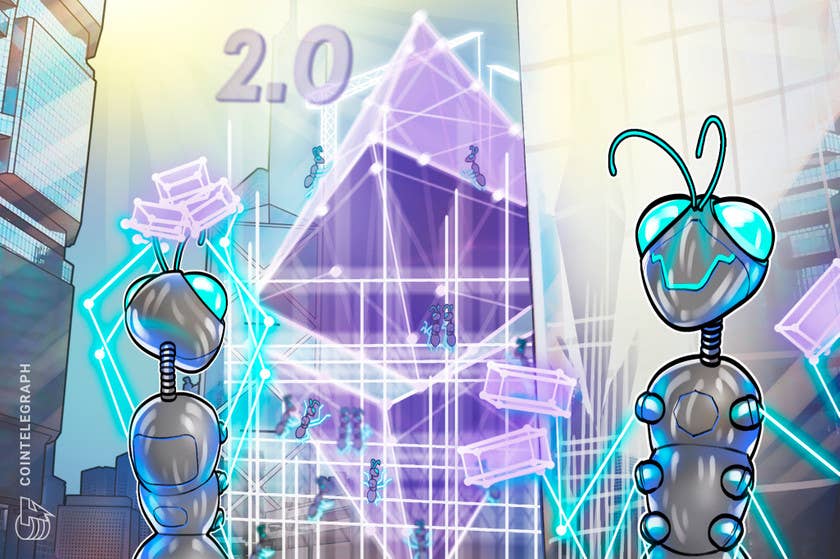The upgrade to Ethereum 2.0 comes with many changes, including the migration to the proof-of-stake consensus algorithm, believed to make the network more secure and compensate participants accordingly.
What is the difference between self-staking and ETH2.0 Staking Earn?
While Ethereum 2.0 staking allows validators to be compensated for securing the network, ‘Ethereum 2.0 Staking Earn’ is its own product, providing users rewards from several DeFi products.
On Ethereum 2.0, the PoS-powered blockchain will bundle 32 blocks of transactions during each validation round. Each block bundle is known as an epoch, which are finalized transactions.
During the validation process, also known as “attesting,” the Beacon Chain assigns groups of stakers into “committees” of 128, who are then given a shard block. A base reward will determine the issuing rate of Ethereum 2.0. As the number of validators connected to Ethereum 2.0 increases, the lower the base reward will be per validator. This is true since the base reward is inversely proportional to the square root of the balance of Ethereum 2.0 validators.
In comparison, Eth2.0 Staking Earn is a product from Matrixport — a financial services platform based in Asia. This product enables users to participate in Ethereum 2.0 staking with a lower threshold while benefiting from rewards associated with other DeFi projects.
Eth2.0 Staking Earn strives to provide a greater yield through established DeFi protocols. The team behind Matrixport shares that the platform is “backed by industry-leading staking providers,” including Lido, the largest decentralized contract for Ethereum 2.0 staking, with over 540,000 ETH staked and Curve.
By utilizing Curve, users benefit from stable currency exchange services with low slippage and low transaction fees. As a result, Ethereum 2.0 Staking Earn results in yields of between 3 and 10% as a result of the 2.30 %of Ethereum 2.0 staking reward, 6.81% of DeFi mining token revenue and 0.14 transaction fee income.
Disclaimer. Cointelegraph does not endorse any content or product on this page. While we aim at providing you all important information that we could obtain, readers should do their own research before taking any actions related to the company and carry full responsibility for their decisions, nor this article can be considered as an investment advice.
What is staking on a proof-of-stake network?
Staking requires users to participate in transaction validation on a proof-of-stake blockchain in exchange for rewards.
In a similar process to mining, staking involves users actively participating in transaction validation on the PoS blockchain. Any user that meets the minimum balance of a cryptocurrency can validate transactions in exchange for staking rewards. On Ethereum 2.0, 32 ETH are required to fully activate the validator software.
Depending on the platform, additional features for “Staking Earn” will allow users to participate indirectly in Ethereum 2.0 through the head-related decentralized finance (DeF)i contract. In addition to receiving part of the ETH lockout bonus, users may be eligible for additional tokens, rewards, fees, income and better liquidity.
What is Ethereum 2.0?
Ethereum 2.0 is a set of interconnected upgrades proposed to make the Ethereum network more scalable, secure and sustainable.
Ethereum 2.0 is the transition from the 1.0 blockchain to a newer version. In Ethereum 2.0, several interconnected upgrades will be put in place by developers with the intent to make Ethereum more scalable, more secure, and more sustainable by focusing on higher speed, or transactions per second (TPS), greater efficiency and higher security. These proposed upgrades are said to occur in three parts.
The first in the list of proposed upgrades is the Beacon Chain, having gone live on December 1, 2020. The Beacon Chain, which includes the migration from proof-of-work (PoW) to proof-of-stake (PoS) consensus algorithm, further enhancing security.
The second phase of the Ethereum 2.0 upgrade is titled “The Merge” and will occur sometime in 2022. As the name states, “The Merge” will merge the mainnet with Beacon Chain, officially migrating from main chain use to the PoW consensus, resulting in greater energy efficiency.
The final phase to also occur in 2022 is the introduction of shard chains to further enhance Ethereum’s storage capacity and data access. Transaction speeds are believed to help extend the network to 64 blockchains.
Why do we need Ethereum 2.0?
The increased use of Ethereum 1.0 has made it difficult for the network to scale due to increased gas fees and slower transaction times.
Crypto developers have adopted the Ethereum (ETH) 1.0 blockchain for its decentralized applications with offerings, including lending, borrowing, pooling and trading as a service. Unfortunately, increased adoption has become a double-edged sword, resulting in high network congestion, increasing gas fees and slow transaction times. To tackle these concerns, Ethereum 2.0 was proposed.

















